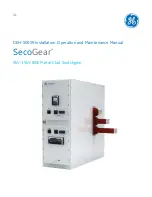
DET-882
SecoGear Medium-voltage Switchgear Application and Technical Guide
Control Power Equipment
©2017 General Electric All Rights Reserved
21
For example, a 6 A charger, fed 115 Vac, and supplying a
125 Vdc battery bank, has an AC load of approximately
13.8 A (6 A x 230%) at full output, or 1590 VA (13.8 A x 115
V). While this would be an intermittent condition, with the
normal load being about 0.5 A to 1.0 A DC, the AC control
source must be sized to handle the 13.8 ampere load.
With automatic control schemes, some relays will be
energized continuously after the first breaker is closed. The
amperes drawn by these relays must be totaled and
included with the indicating lamp load, and others, to arrive
at the total steady state load.
Emergency loads on switchgear batteries, such as room
lights or DC pump motors will be powered only by a
specific time and then extinguished; lights will usually be
used for only three hours and the duration of a motor load
must be specified by the user.
CONTROL POWER SOURCE SELECTION
To select the proper control power source including size of
the battery and control power transformer, establish the
size of the load, then, determine the short-time loads, such
as breaker tripping and steady load; remember to convert
to a common rate base.
Considering the relatively small demand loads on the
control power source by individual breakers, it becomes
critical to identify and total other loads, because these are
the loads that may represent the major demand. Always
keep in mind to set a period of time for longtime loads
since a battery bank, with the charger “off,” is not a
“continuous” source.
DC Control Power Equipment
GE does not design, manufacture, or test storage batteries.
GE Switchgear Operations, when required, will select and
furnish batteries and their charger as specified by the
customer and in accordance with the requirements of the
switching devices and the overall station operation.
The battery bank should be connected to the DC control
power bus and the charger at all times, representing the
complete DC control power equipment. The battery bank
has plays a small part in the normal operation of the
control power; however, it has a very important work to
supply the large momentary loads.
Battery Systems
Lead-Acid Batteries
Common lead-acid battery types:
•
Pasted plate, with lead-antimony grids
•
Lead-calcium; a pasted-plate construction with calcium
replacing antimony as the additive for grid strength
Pasted plate, lead antimony, is the basic lead-acid battery,
familiar in another form as the automobile battery. For
control work (compared to auto batteries), thicker plates
and lower gravity of acid provide longer life and allow long-
time trickle or “float” charging. With different plate
thicknesses, expected life is from 6 to 14 years.
Lead-calcium construction has longer expected life (up to
25 years) than lead-antimony at a rather small increase in
cost. The “pure lead” electrochemical characteristics,
compared to the other classes, require slightly different
(higher) charging voltages.
Nickel-Cadmium Batteries
Nickel-cadmium batteries are more expensive than lead-
acid, in general, but have advantages. Maintenance is less;
life is longer; low-temperature discharge currents are
higher for a given size; and they can be charged more
rapidly.
Pocket-plate cells are the normal construction used with
switchgear; they are made in three different plate
thicknesses. The thickest plates are not suitable for short-
time applications. Medium or thin-plate cells are used with
switchgear; the choice depending upon the relative
amounts, respectively, or long- or short-time load.
Sintered-plate construction, which is relatively new, is used
mostly in “cordless” appliances, seldom in switchgear.
Table 3-6: Battery Selection Guide
Factor
Lead-Acid
NiCad
Initial Cost
Lower
Higher
Maintenance
Higher
Lower
Life expectancy
Lower
Higher
Battery Capacity and Sizing
The capacity of a storage battery is usually expressed in
ampere-hours (1 A for 1 h, or the product of amperes
output multiplied by hours of discharge, with the basic rate
being eight hours). Battery capacity, however, may be
expressed at many time-rates other than the eight-hour
rate.
For switchgear short-time loads, such as breaker tripping,
the one-minute rate per cell (discharging to 1.75 V for lead,
or 1.14 V for nickel-cadmium) is used. The one-minute rate
does not exhaust the battery completely; rather, it is the
rate that causes the terminal voltage to drop to the stated
value early in the discharge period.
Further, the actual value of discharge capacity of a storage
battery may vary over a wide range with battery
temperature. Published data is for cells at 25 °C [77 °F], and
battery rating factors must be reduced when the battery is
at a lower temperature. For capacity rating factors refer to
IEEE worksheets.












































